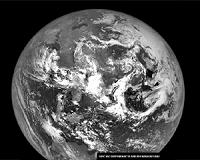 |
Bonn, Germany (SPX) Oct 22, 2010 A couple of clicks of the mouse are enough to send the ExoMars rover with its six flexible metal wheels moving across the sand tank towards the first obstacle. Bernhard Rebele, Maximilian Apfelbeck and Sebastian Kuss from the German Aerospace Center Institute of Robotics and Mechatronics have built a challenging obstacle course, which really puts the rover to the test. Its middle wheels scrabble obstinately against the sharp edges of the limestone. The steady grinding sound as the rover passes over the pebbles in the sand turns into an unpleasant creaking. At last, the small metal teeth manage to get a grip, and the Mars rover crawls upwards inch-by-inch until the rearmost pair of its six wheels has cleared the obstacle. The industrial stone is 25 centimetres high - the European Space Agency (ESA), which will be sending the rover into space in 2018, has set rigorous specifications for the tests it has to pass at DLR.
Journey on foot over a martian dune He means that the rover has been fortunate; the sand is neither too coarse nor too fine. Walking through the 5.5 by 10 metre tank gives a good idea of what it would feel like to take a stroll on a martian dune. It was not easy to select the correct sand - not all sand is like what can be expected on Mars. Since no soil sample has yet been returned to Earth from Mars, ESA has had to rely on microscope images and photographs of the planet's surface, for example of the walls of actual Mars rover tracks, to evaluate what the sand is like there. The sand was then prepared specially for the tests. The trials at DLR Oberpfaffenhofen are attempting to establish: "How deep the rover's tracks are, how much drive the wheels produce, and what types of obstacles it can drive over," Bernhard Rebele summarises, while the rover drives through the special silica sand from England.
Computer simulation The ExoMars rover is now driving towards a surface covered in misshapen stones. It most probably will never have to drive on such uneven ground, but the researchers want to obtain as much data as possible. "In this way, we can optimise our computer simulations," explains project leader Bernd Schafer. When differences between the simulation and the test rover are found, the new data are incorporated into the computer model. Later, many tests for the ExoMars rover will not have to be conducted in the 'real' world, because computer simulations will give the researchers the information they require. The findings could also be useful for future missions; if it is planned to allow a rover to travel independently over unfamiliar terrain, using a stereo camera to guide it, or to use a swarm of small crawlers - crab-like rovers with many legs - these activities can be tested out in computer simulations before the event.
Mars-like conditions A tower mounted on top of rover simulates the exact location of the centre of gravity of the rover and the payloads that ExoMars is designed to transport across the martian surface. The rover can drive 100 metres per hour: "But it will more likely be covering such a distance in a day, to prevent damage to the electronics," explains Schafer. Maximilian Apfelbeck has stationed himself at the end of the tank, as a precaution. The rover is working slowly up the slope created for it by the researchers. It must be able to drive up slopes of 26 degrees to meet ESA's specifications. Sebastian Kuss continually looks over to the slope, while controlling the rover with his mouse. The steep slope is a challenge for the rover and the team. The wheels are finding it difficult to gain traction in the loose sand. Finally, Kuss sends it the command to retreat. At the end of the test sequence, a camera on an arm scans the entire surface of the test tank and the computer builds a three-dimensional map of the surface. The vehicle's tracks and all the obstacles are precisely recorded. The scientists now have to analyse the data from the test sequence and incorporate it into their computer models. The tank contents have to be precisely rearranged for the next test sequence, to imitate the conditions on Mars as closely as possible. The scientists have to rake through the sand, add gravel and roll it all flat.
Treacherous sand for a rover Maximilian Apfelbeck kneels in front of one of the containers. His finger disturbs a finely ground sand, the same colour and consistency as flour. "NASA also uses this sand," he says. Just this kind of surface brought the Spirit rover to a halt on Mars. ExoMars must not suffer the same fate.
Share This Article With Planet Earth
Related Links German Aerospace Center (DLR) Mars News and Information at MarsDaily.com Lunar Dreams and more
 The Earth Is Not Round
The Earth Is Not RoundBethesda MD (SPX) Oct 19, 2010 Some 50 years ago, when the first artificial satellite was launched, it was generally thought the Earth was spherical in shape. Of course, the existence of surface anomalies such as mountains, valleys and ocean floor contours were well known, but not well understood in terms of their effects on satellite orbits near the Earth. Studies of the moon's motion had given some indication that the ... read more |
|
| The content herein, unless otherwise known to be public domain, are Copyright 1995-2010 - SpaceDaily. AFP and UPI Wire Stories are copyright Agence France-Presse and United Press International. ESA Portal Reports are copyright European Space Agency. All NASA sourced material is public domain. Additional copyrights may apply in whole or part to other bona fide parties. Advertising does not imply endorsement,agreement or approval of any opinions, statements or information provided by SpaceDaily on any Web page published or hosted by SpaceDaily. Privacy Statement |